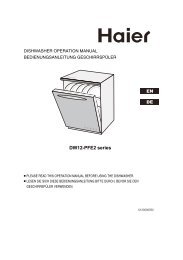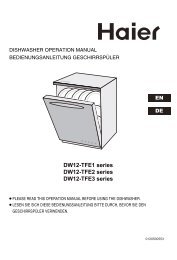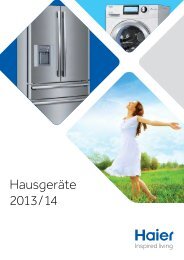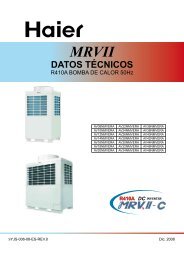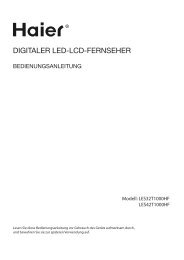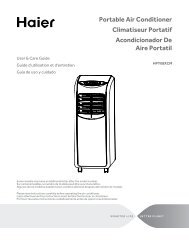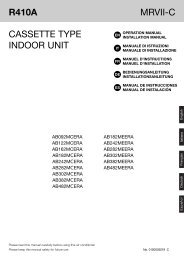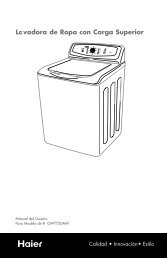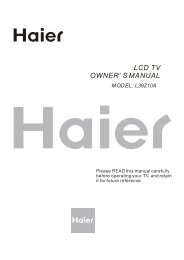AFD631CX AFD631CB AFD631CS AFD634CX ... - Haier.com
AFD631CX AFD631CB AFD631CS AFD634CX ... - Haier.com
AFD631CX AFD631CB AFD631CS AFD634CX ... - Haier.com
Create successful ePaper yourself
Turn your PDF publications into a flip-book with our unique Google optimized e-Paper software.
Preparation prior to use<br />
Note<br />
Connection to power supply<br />
When the refrigerator is connected to power supply, the fridge temperature and freezer<br />
temperature are automatically set to 5 and -18 respectively.<br />
Operation modes of the refrigerator<br />
Manual adjustment mode: can set temperature by pressing the temperature setup key<br />
(see “Function description” hereafter).<br />
Loading the refrigerator with food<br />
Load the refrigerator with food after it has been operates for<br />
a period and the inside is cool enough.<br />
Some time will be required for the refrigerator to reach the set temperature when<br />
the setting is changed. The length of this period depends on the difference between<br />
the existing and set temperatures, ambient temperature, door opening frequency<br />
and the amount of food in storage.<br />
Safety instructions for installation<br />
Never place the refrigerator in a damp area or location where it might be splashed with water.<br />
Clean and dry water splashes and stains with a soft clean cloth.<br />
The refrigerator should be placed in a well-ventilated place not far from a drink water source.<br />
Ensure a space of at least 20 cm above and 10 cm around the refrigerator.<br />
Keep ventilation openings in the appliance or in the in-built structure clear of obstruction,<br />
The refrigerator is operated by a 220-240 VAC/50 Hz power supply. Abnormal voltage fluctuation<br />
may cause the refrigerator to fail to start, or damage to the temperature control or <strong>com</strong>pressor, or<br />
there may be an abnormal noise when operating. In such case, an automatic regulator shall be<br />
mounted.<br />
A dedicated socket with reliable grounding must be provided for the refrigerator. The refrigerator's<br />
power cable is fitted with a 3-pin (grounding) plug that fits a standard 3-pin (grounding) socket.<br />
Never cut off or disassemble the grounding.<br />
The appliance must be positioned so that the plug remains accessible.<br />
If the supply cord is damaged, it must be replaced by the manufacturer, its service agent or<br />
similarly qualified persons in order to avoid a hazard.<br />
Do not damage the refrigerant circuit.<br />
Safety instructions for installation<br />
The Ice Maker and its water hose should be installed and tested by authorized professional<br />
personnel.<br />
Cut the water hose to the desired length while ensuring that it does not bend excessively.<br />
Generally, its total length is not more than 5 meters. Longer hoses may reduce the water pressure<br />
and produce poor ice making results.<br />
The water hose should not be in contact with any heat sources as it is not heat-resistant.<br />
The Ice Maker should be connected to a water source with a pressure between 150 and 700<br />
Pascal.<br />
Never install the Ice Maker hose in an area where the ambient temperature can drop to 0° C to<br />
avoid icing.<br />
The Ice Maker will start making ice when the internal temperature reaches -12° C.<br />
After the device is positioned, the hose should be properly arranged to prevent it from being<br />
crushed.<br />
This Ice Maker must be supplied from a drink water source.<br />
If the Ice Maker is used for the first time or after not being used for a longer period, the first loads<br />
of ice cubes should be discarded as there may be impurities in the water hose.<br />
For a newly installed refrigerator, please let the appliance operate for 24 hours before making ice.<br />
The hose-set is delivered with the device and must be used. New hose-sets are only available via<br />
the customer service.<br />
9



